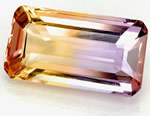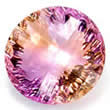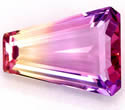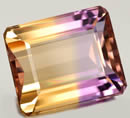Ametrine from Bolivia
 Most gemstones are found in multiple locations in the world. Gems that are found in just a single location, such as tanzanite, tend to be quite expensive. But that is not the case with ametrine. Though virtually all the world's supply of ametrine comes from a single mine -- the Anahi mine in southeastern Bolivia -- ametrine continues to be a very affordable gem, though prices have been rising over the last decade.
Most gemstones are found in multiple locations in the world. Gems that are found in just a single location, such as tanzanite, tend to be quite expensive. But that is not the case with ametrine. Though virtually all the world's supply of ametrine comes from a single mine -- the Anahi mine in southeastern Bolivia -- ametrine continues to be a very affordable gem, though prices have been rising over the last decade.
 The Anahi mine has been known for hundreds of years. The story is that the mine first became famous in the seventeenth century when a Spanish conquistador received it as a dowry when he married an Ayoreos princess named Anahi. Ametrine crystals were first introduced to Europe through the conquistadors's gifts to the Spanish queen. However, ametrine has only been available on the market in any quantity since about 1980. The Anahi mine is also one of the world's largest producers of high quality amethyst.
The Anahi mine has been known for hundreds of years. The story is that the mine first became famous in the seventeenth century when a Spanish conquistador received it as a dowry when he married an Ayoreos princess named Anahi. Ametrine crystals were first introduced to Europe through the conquistadors's gifts to the Spanish queen. However, ametrine has only been available on the market in any quantity since about 1980. The Anahi mine is also one of the world's largest producers of high quality amethyst.
 Amethyst and citrine are both forms of quartz and are often found in the same locations. But it is rare for both colors of quartz to be found in the same crystal. Both citrine and amethyst are colored by traces of iron, but the color of the zones visible within ametrine are due to differing oxidation states of iron within the crystal. The different oxidation states occur due to temperature differences across the crystal during its formation.
Amethyst and citrine are both forms of quartz and are often found in the same locations. But it is rare for both colors of quartz to be found in the same crystal. Both citrine and amethyst are colored by traces of iron, but the color of the zones visible within ametrine are due to differing oxidation states of iron within the crystal. The different oxidation states occur due to temperature differences across the crystal during its formation.
Ametrine is most typically faceted in a rectangular shape with a 50/50 pairing of amethyst and citrine. Sometimes a checkerboard pattern of facets is added to the top to increase light reflection. Ametrine can also be cut to blend the two colors so that the result is a mixture of yellow, purple, and peach tones throughout the stone.
The classic 50/50 split is actually a very inefficient use of the rough material and typically requires that all stones be cut in an emerald cut. Now we are starting to see more intriguing cuts with a 70/30 to 90/10 split of colors. Some interesting new cuts have 3 or more color zones, and some have orange hues as well as purple and gold.
 Most gemstones are found in multiple locations in the world. Gems that are found in just a single location, such as tanzanite, tend to be quite expensive. But that is not the case with ametrine. Though virtually all the world's supply of ametrine comes from a single mine -- the Anahi mine in southeastern Bolivia -- ametrine continues to be a very affordable gem, though prices have been rising over the last decade.
Most gemstones are found in multiple locations in the world. Gems that are found in just a single location, such as tanzanite, tend to be quite expensive. But that is not the case with ametrine. Though virtually all the world's supply of ametrine comes from a single mine -- the Anahi mine in southeastern Bolivia -- ametrine continues to be a very affordable gem, though prices have been rising over the last decade. The Anahi mine has been known for hundreds of years. The story is that the mine first became famous in the seventeenth century when a Spanish conquistador received it as a dowry when he married an Ayoreos princess named Anahi. Ametrine crystals were first introduced to Europe through the conquistadors's gifts to the Spanish queen. However, ametrine has only been available on the market in any quantity since about 1980. The Anahi mine is also one of the world's largest producers of high quality amethyst.
The Anahi mine has been known for hundreds of years. The story is that the mine first became famous in the seventeenth century when a Spanish conquistador received it as a dowry when he married an Ayoreos princess named Anahi. Ametrine crystals were first introduced to Europe through the conquistadors's gifts to the Spanish queen. However, ametrine has only been available on the market in any quantity since about 1980. The Anahi mine is also one of the world's largest producers of high quality amethyst. Amethyst and citrine are both forms of quartz and are often found in the same locations. But it is rare for both colors of quartz to be found in the same crystal. Both citrine and amethyst are colored by traces of iron, but the color of the zones visible within ametrine are due to differing oxidation states of iron within the crystal. The different oxidation states occur due to temperature differences across the crystal during its formation.
Amethyst and citrine are both forms of quartz and are often found in the same locations. But it is rare for both colors of quartz to be found in the same crystal. Both citrine and amethyst are colored by traces of iron, but the color of the zones visible within ametrine are due to differing oxidation states of iron within the crystal. The different oxidation states occur due to temperature differences across the crystal during its formation. |
The classic 50/50 split is actually a very inefficient use of the rough material and typically requires that all stones be cut in an emerald cut. Now we are starting to see more intriguing cuts with a 70/30 to 90/10 split of colors. Some interesting new cuts have 3 or more color zones, and some have orange hues as well as purple and gold.

No comments:
Post a Comment